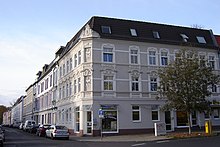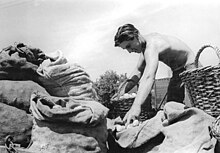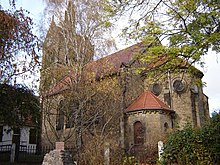Lemsdorf
|
Lemsdorf district of Magdeburg |
|
|---|---|
| Basic data | |
| Surface: | 1.3257 km² |
| Residents : | 2188 |
| Population density : | 1,650 inhabitants per km² |
| (Information as of December 31, 2016) | |
| Coordinates : | 52 ° 6 ' N , 11 ° 36' E |
| Districts / Districts: | Alt Lemsdorf Kleiner Harz Goslarer Strasse Ballenstedter Strasse |
| Postal code : | 39118 |
| Bus routes : | 57 58 |
With an area of 1.3257 km², Lemsdorf is the second smallest district in Magdeburg , the capital of Saxony-Anhalt , after Brückfeld , and has 2,188 inhabitants (as of December 31, 2016).
geography
Lemsdorf is located in the southwestern part of Magdeburg, five kilometers from the city center on the southern slope of the Hängelsberg and Junkerberge mountains to the west, at an altitude of between 60 and 70 meters above sea level. The Magdeburger Ring ( Bundesstrasse 71 ) essentially forms the border to the east, where the Reform district adjoins. Ottersleben borders Lemsdorf both in the south and in the west, and to the north-west lies the Sudenburg district .
The Klinke -Bach flows around Lemsdorf to the south and east, and the Eulebach flows into the Klinke near Inselstrasse. The Sebastiansgraben runs along the southern border.
Apart from the Harzburger Strasse and Neinstedter Strasse, where multi-storey apartment buildings are located, the development primarily corresponds to the character of a small suburban settlement. To the west, where the landscape of the Magdeburger Börde already begins, the district turns into agricultural use. Lemsdorf is not connected to the Magdeburg tram network; local public transport is handled by two bus routes.
history
" Liemuntestorf " was first mentioned in a document on September 21, 937 in connection with the assignment of the place to the Magdeburg Moritzkloster by Otto I. The place name is obviously derived from the Old Saxon personal name Liamund, and the ending - torp suggests a Germanic place foundation close, which could date back to the 7th century. After the foundation of the Magdeburg Archbishopric and the Berge Monastery in 968, taxes had to be paid to both.
Presumably as early as the 13th century, Lemsdorf owned a 120 m² church made of field stones with a thick-walled tower. It was consecrated to Saint Sebastian and was a branch of the mother church of St. Stephani in Groß Ottersleben. At the beginning of the 14th century, a Benedictine monk was entrusted with the spiritual care of Lemsdorf . For some time the place was under the sovereignty of the County of Billingshoch, which lasted until 1316. Then the village came to the Hildesheim canon Heinrich von Barby. In 1427 Lemsdorf was again liable for taxes to the Berge monastery.
Lemsdorf was away from important trade routes, only the “Königsweg” led past the town at some distance to the west. Its development was very slow, and from the Middle Ages onwards the structures were dominated by agriculture. A sheep farm of the Magdeburg Dompropstei was located here since the 12th century. At the end of the 17th century there were 13 farmers and a water miller. In 1822, the landlord Köhne, who worked in Lemsdorf, had a large estate built in the form of a four-sided courtyard on Harzburger Strasse.
Between 1349 and 1683 the residents of Lemsdorf were hit fourteen times by plague epidemics . Lemsdorf was not spared from the armed conflicts of the 16th and 17th centuries. When the city was besieged in connection with the enforcement of the imperial ban against Magdeburg, Duke Georg zu Mecklenburg pitched his army camp near Lemsdorf on January 25, 1551 . The Thirty Years War hit the place hard. In 1625, the imperial troops reduced the village to rubble and ashes. The few remaining inhabitants were expelled by Tilly's troops in 1632 . Subsequently, the number of inhabitants in Lemsdorf grew slowly at first, 1684: ~ 80, 1781: 113, 1840: 292. In 1750 a school was set up in Lemsdorf for the first time under church care, but in 1774 the school building burned down again. The reconstruction cost 620 thalers and brought the parish into considerable debt. In 1780 mulberry trees had to be planted on the orders of the Prussian King Friedrich II , as Prussia wanted to become independent of silk imports from China by raising silkworms. However, the action was unsuccessful because of the poor climatic conditions.
After the defeat of Prussia by Napoleon I , Lemsdorf came under French rule in 1807 and until 1814 belonged to the Kingdom of Westphalia of the Napoleon brother Jérome. During this time, the Lemsdorf houses were given numbers for the first time, with the farmsteads of the landowner Köhne being given the numbers 1 and 2. In the course of the wars of liberation , the residents of Lemsdorf were forced by the French occupation in August 1813 to dig entrenchments in front of the town. When a regional reform was carried out in Prussia in 1815 after the war, Lemsdorf became part of the Wanzleben district and was merged with Klein Ottersleben to form an administrative district.
In the work on the flora of Magdeburg developed by the botanist Paul Ascherson and published in 1864, the landscape around Lemsdorf and the plants found there are also mentioned. This is how the occurrence of field cress and hair awl grass on a ravine north of Lemsdorf and the real night carnation on the way from Sudenburg to Lemsdorf were described. Marsh dock was found at the latch near Lemsdorf. The swamp pond thread appeared in the latch and "in the pond" . The stalkless Targant that had previously been found near Lemsdorf had already disappeared by this time.
In the course of the further expansion of the Magdeburg Fortress , the so-called Fort IIa was built in Lemsdorf around 1870.
The construction of the new country road between Sudenburg and Groß Ottersleben away from Lemsdorf in 1890 initially had a negative effect, as the direct connections to the neighboring towns were now cut. After the fortress restrictions for Magdeburg were lifted at the end of the 19th century, the city moved ever closer to Lemsdorf, and numerous Lemsdorfers had found work in Magdeburg. Within fifty years the population increased from around 300 to 811 in 1900. Apparently the old church had also become too small, because in November 1887 it was blown up by Magdeburg pioneers. On August 16, 1889, the foundation stone for a new church was laid and on November 9, 1890, the inauguration took place. The Lemsdorf school, which is still administered by the church, was transferred to the municipality in 1906.
In the course of the city expansion of Magdeburg, Lemsdorf was incorporated on April 1, 1910. Before that, there had been resistance for years from influential Lemsdorf large farmers who threatened to lose their court battle privilege when they joined Magdeburg. Only after the promise that the privilege would continue to apply for ten years and that there would be improvements in the electricity and water supply as well as in road construction was the resistance given up. At the time of incorporation, Lemsdorf already had 3,277 inhabitants. Since only 19 residents were employed in agriculture, the agricultural character of the place was pushed back more and more in favor of a housing estate, and numerous multi-storey apartment buildings were built. Some street names have been changed:
- Krugstrasse became Quedlinburger Strasse
- Sudenburger Weg became Blankenburger Strasse
- Otterslebener Weg became Ballenstedter Strasse
After the First World War , Lemsdorf was designated as the first location in Magdeburg for housing construction for the unemployed, which was subsidized by the Reich government. With their own work done by the future residents, the Kreuzbreite settlement was built in 1932 in the south of the district. 25 semi-detached houses with 50 m² apartments were built. As part of the National Socialist housing program, the GAGFAH settlement (“Gemeinnützige Aktiengesellschaft für Anarbeiter-Heimstätten”) was built in 1938 with 29 two-story apartment blocks, which were equipped with 314 so-called people's apartments of low standard. In 1939 Lemsdorf had grown to 6,002 inhabitants. In 1942 a prisoner of war camp was set up on Akazienbusch Street. The bomb attacks on Magdeburg in 1944 and 1945 did not cause any damage in Lemsdorf.
Due to the poor transport connections, there was no significant housing construction or industrial settlements either during the GDR era or afterwards. Rather to the detriment of the townscape, the old school was torn down in the 1990s and replaced by a monumental building for a craftsman training center. The Köhnehof, which was unused after 1990, was left to decay and finally demolished in 2004. Several almost completely empty streets also have a negative effect on the appearance of Lemsdorf. In 2007, the oldest surviving house in Lemsdorf, Im Winkel 2 , was demolished for the purpose of expanding a business.
Economy and local politics
In 2000 there were 84 small businesses and 27 craft businesses in Lemsdorf. At that time, three resident doctors and a dentist were available for medical care. Today the district has neither a post office nor a savings bank branch. The elementary and secondary schools were also closed.
Since an application by the parliamentary group of the Green Party in the Magdeburg city council to establish local councils for the Magdeburg districts failed, there is no local political representation for Lemsdorf. The result of the elections for the Magdeburg City Council looked like this for Lemsdorf in recent years:
| SPD | CDU | PDS | Green | FDP | FWG | future! | ||
|---|---|---|---|---|---|---|---|---|
| 1994 | 44.1% | 24.3% | 16.3% | 9.1% | 3.1% | 3.1% | - | |
| 1999 | 27.9% | 41.1% | 15.8% | 3.7% | 3.1% | 4.1% | ? (is missing) | |
| 2004 | 21.6% | 27.2% | 27.2% | 4.9% | 10.7% | - | 5.3% | (without postal voting) |
Special structures
The cultural monuments in the district are listed in the local monument register .
The Protestant St. Sebastian Church , built in neo-Romanesque style in 1890, is located in the center of the district.
One of the most striking buildings in Lemsdorf is the Köhne Villa on Harzburger Strasse . It was built in 1886 by order of the landowner Köhne according to plans by the master carpenter Ketzer in the Wilhelminian style. The building is two-story and has an H-shaped floor plan. Yellow bricks were used for the facades. The lower windows are covered with triangular or semicircular canopies, and the side wings are decorated with ornate gables, on each of which a medallion with a plastic horse's head has been attached. The entrance portal is framed by two columns. There is a small park behind the villa.
Personalities
- Albert Fischer (born April 18, 1829 in Ziesar, † April 27, 1896 in Lemsdorf), theologian and hymnologist
swell
- Georg Dehio: Handbook of German art monuments, Saxony-Anhalt I . Deutscher Kunstverlag, 2002, ISBN 3-422-03069-7 .
- Magdeburg - architecture and urban development . Verlag Janos Stekovics , 2001, ISBN 3-929330-33-4 .
- Magdeburg and its surroundings (= values of our homeland . Volume 19). 1st edition. Akademie Verlag, Berlin 1973.
- Matthias Puhle, Peter Petsch (eds.): Magdeburg 805-2005 . Verlag Janos Stekovics, 2005, ISBN 3-89923-105-8 .
- CD Saxony-Anhalt - Official topographic maps . State Office for Land Surveying and Geoinformation, 2003.
- Kurt Kühle private chronicle, 1982.
Web links
Individual evidence
- ↑ District catalog of the Office for Statistics
- ^ Paul Ascherson: Flora of the province of Brandenburg, the Altmark and the Duchy of Magdeburg. Third department. Special flora of Magdeburg. Published by August von Hirschwald, Berlin 1864.
- ↑ Opinion 0144/12 of Magdeburg, Appendix 1, Part 2, approved termination requests by the upper conservation authority 2002-2010.








